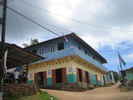A few miles from Espiritu Santo to San Miguel VillageAfter raising the anchor and departing Espiritu Santo, we made our way out of the channel and out to the ocean. GALLIVANT & CARAVAN were right behind us, heading to the island of Mogo Mogo. The weather forecasts called for a tropical wave coming thru in the next few days, and we didn't feel Mogo Mogo was a good rough-weather anchorage. Our plan, instead, was to find a nice protected anchorage, namely the one at Isla Ampon, between it and Isla Casaya, and on the way, to visit the village of San Miguel. We had talked to the other cruisers hanging around E. Santo and none of them had ever been to the village, so we thought it would be fun to check it out. So, a very short time after leaving Espiritu Santo, we found ourselves rounding the corner to come into the bay at San Miguel. In order to get there, one has to be very wary of several small islets and reefs. The anchorage is not directly off the village, but 1/2 mile or so to the west. As we got into the bay there was one other boat of some size, a small trawler, anchored there. We dropped the hook in about 10' of water right at low tide and quickly were in the dinghy headed to shore. The dinghy landing was somewhat problematic. In front of the village were a number of pangas, a few floating, but most "beached" on a flat in front of the village. As we approached in the dinghy, the water got really shallow at 100+ yards out. When we were 50 yards out, we were forced to put away the motor and row thru 1-2' of water. Then with still 20 yards or so to go to the flat, the dinghy bottomed out and we had to get out and drag it the rest of the way to "shore". The bottom was an oozy, messy muck and after almost losing our sandals, we both had to go barefoot, sinking 6-8 inches into the mud with each step, in the tepid 85-90 degree water and slime. Then when we got to the flat, we realized that it was a mud flat, not solid at all. The pangas there were on anchors and ropes that were just sitting in the mud. At high tide they would be in 10-12' of water, but now they were just laying in the ooze. So as quick as we could, we hauled the dinghy up onto the mud aways, tied it off to one of the pangas, and slogged across the flat towards the town carrying our shoes. After another 50 yards or so in, the ground became solid and we were able to rinse our feet off in the dirty water and don our sandals. The village of San Miguel is nice enough. Clearly not at all geared up to be a tourist town, we received a bit of scrutiny, but a generally warm welcome, as we wandered around. The first people we met were a couple of guys from the Servicio Maritimo, kind of like the Coast Guard, who have a little office overlooking the mud flat. They had watched us with some amusement as we made our way ashore. They said it was ok when we referred to the location of the dinghy, and we asked them for directions to the tienda(s), which they told us in Spanish. The village has several paved roads, and we walked up one and went into a small tienda. It was a very small store and dealt mostly in dry goods. Specifically we were looking for eggs, veggies, and bread, so we went to another tienda. This one was under a billiard room and bar, and even at 11:00 am, there were a couple of guys hanging around drinking beers. It was a hot day, and they didn't have any bread, so we decided instead to get a beer and take a break. We sipped our beers and walked a little more around the village, wanting to put off the mud-flats for a while. Finally, when we got back to the Servicio Maritimo office and looked out at the dinghy, it was floating in about 8 inches of water, now making it about 10 yards "off shore". We trudged back thru the muck, got in the dinghy, and rowed it for awhile with our feet hanging over the side to rinse the mud off. Finally, about 100 yards later, we were in deep enough water to lower and start the motor, which we did. We got back to RHAPSODY at about 1:30 pm, breadless, but glad to have visited the village. From there we upped anchor and motored the short distance to the anchorage at Isla Ampon. Although commonly referred to as "Ampon", the anchorage is actually in a bay of Isla Casaya, with the smaller Isla Ampon protecting the entrance. By looking at the map above you can see how well protected this anchorage should be from the expected south swells and north winds and wind-waves that we were expecting in the next few days. |







